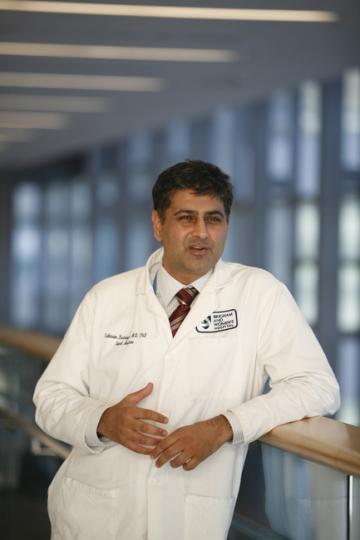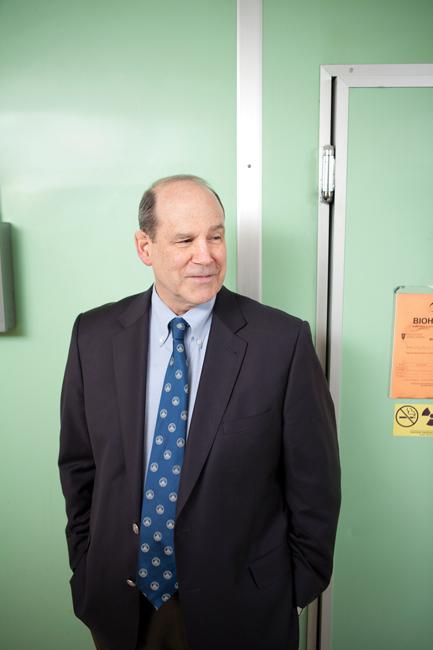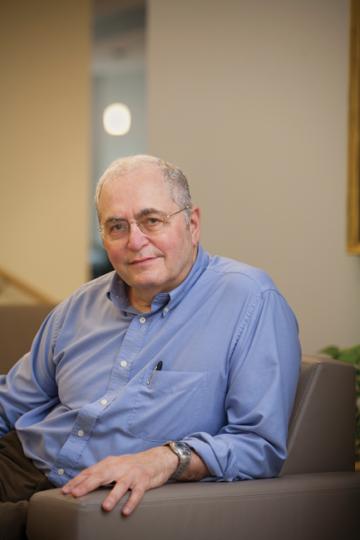Epidemic Proportions
The fight against infectious diseases increasingly links discovery with care
- Feature

When Mycobacterium tuberculosis invades a person’s body, it doesn’t just settle into the lungs and look for a spot from which to eke out a living. It hijacks that person’s macrophages—cells that attack invading bacteria—and uses the mechanisms of inflammation to manipulate the environment around it, remodeling its new home to suit its needs.
Salmaan Keshavjee knew about Mycobacterium’s penchant for makeovers, and thought that this knowledge might be useful in the fight against tuberculosis. So he was intrigued when he learned of an unusual approach that researchers at Sweden’s Karolinska Institutet were taking to control these bacteria-orchestrated renovations.
To understand this twist in the body’s normal path of self-defense, and to find ways to get the immune response back on track, the Sweden-based team, led by Markus Maeurer, a professor of clinical immunology at the institute, had cultured the mesenchymal stem cells from patients with extensively drug-resistant tuberculosis (XDR TB), then reinfused the patients with those cultured stem cells. Because mesenchymal stem cells help suppress inflammation, the researchers wanted to see if they could safely dampen and refocus the inflammatory response without compromising immune function.

“Their preliminary data suggested that the stem cells didn’t suppress immunity in an adverse way, and surprisingly, the patients who received the transplanted cells did much better on their XDR TB treatment than typical patients in their condition,” says Keshavjee, an HMS associate professor in the Department of Global Health and Social Medicine and a physician in the Division of Global Health Equity at Brigham and Women’s Hospital. With the treatments now in use, fewer than a third of patients with XDR TB recover, but in this small initial study, all the participants appeared to recover.
Keshavjee is developing a partnership with the institute’s team, laying a foundation for more-extensive trials of the treatment in Russia and Peru. “Saving lives from a disease that’s killing people—that’s always good,” Keshavjee says. “But this work also opens the door to thinking about tuberculosis differently. If the mycobacterium is manipulating its environment by modulating T cells and other immune cells, we need to ask, ‘What if we unmodulate that environment?’ ”
“Inside our bodies, the bugs are living in an ecosystem,” he adds. “As humans, we also have our own ecology, which plays out in society. Recognizing the complex biosocial nature of infectious diseases moves you toward some crucial insights about how these diseases work and how to fight them.”
To fight infectious diseases worldwide, biomedical researchers and clinicians are joining efforts to apply laboratory-based discoveries to the challenge of saving the lives of people with tuberculosis, cholera, and other age-old ravages. These international collaborations are increasingly considering such diseases in context, as integrated parts of complex interconnected systems that involve humans.

“We now have genomic and proteomic platforms that are beginning to have immediate relevance to the challenges of diagnosing and treating infectious disease in poor communities,” says Paul Farmer ’90, the Kolokotrones University Professor at Harvard, head of the Department of Global Health and Social Medicine at HMS, and a cofounder of Partners In Health, an international nonprofit that brings health care to the poor. “Many of these new technologies are more portable, scalable, and affordable than ever before.”
In Black and White
Tuberculosis is a global public health issue that is unevenly distributed: the burden of the disease is highest in Asia and Africa, with India and China accounting for almost 40 percent of cases. Africa has 24 percent of the world’s cases and the highest rates of disease and death per capita. In the Russian Federation, XDR TB is a particular concern: it has rapidly spread through prison populations. In Peru, while the incidence of tuberculosis is decreasing, the incidence of multidrug-resistant tuberculosis is on the rise. Overall, according to a 2012 report from the World Health Organization, there were an estimated 8.7 million new cases of tuberculosis and 1.4 million deaths worldwide from the disease in 2011.
Similar sobering statistics can be found for cholera. Although up to 80 percent of cholera cases can be successfully treated with low-cost oral rehydration salts, the WHO estimates that annually more than 100,000 people succumb to the disease.The impact of cholera is most acute in regions with poor sanitation and unsafe supplies of drinking water, conditions that annually spawn three to five million cases worldwide. The entire country of Bangladesh is considered at high risk for this disease, the only country with this designation from the WHO.
Delete Buttons
Like tuberculosis, cholera elicits a complex immune response. The infection takes place in the mucosal membrane of the small intestine, where billions of beneficial bacteria live. Our gut microbiota perform welcome chores such as fermenting carbohydrates to release their useful energy. Although our gut mucosa is always on the alert for foreign bacteria, killing every newcomer would be imprudent, as some may be useful in maintaining the health of their human host. Yet when a pathogen is identified, the mucosal cells mount a vigorous immune response.

Unfortunately, the basic mechanisms of that response are still poorly understood. This knowledge gap has hindered the development of effective, durable vaccines for diseases such as cholera. In fact, current vaccines offer only partial protection that lasts for just a few years.
To extend this protection, or perhaps even block the disease permanently, researchers, including John Mekalanos, the Adele H. Lehman Professor of Microbiology and Molecular Genetics and head of the Department of Microbiology and Immunobiology at HMS, are tweaking the genetic makeup of Vibrio cholerae. The trick has been determining how to eliminate the genes that turn off the disease without disturbing the ones that elicit an immune reaction. Mekalanos, along with Mike Levine at the University of Maryland, has pioneered the use of a live oral cholera vaccine. This vaccine uses a genetically altered version of the organism that is unable to cause disease.
In addition to learning which genes halt the cholera bacterium, it is necessary to understand which ones are activated during its transmission and infection. Stephen Calderwood ’75, the Morton N. Swartz, M.D. Academy Professor of Medicine (Microbiology and Immunobiology) at HMS and Massachusetts General Hospital, is looking at gene expression at different points in V. cholerae’s life cycle to determine which genes are expressed by the pathogen during infection, as well as which trigger immune responses in the human host.
For this research, Calderwood is collaborating with clinicians and researchers at the International Centre for Diarrhoeal Disease Research in Dhaka, Bangladesh. Calderwood’s team has collected thousands of samples from patients who have been hospitalized with severe cholera.
The Sniff Test

The insights from such molecular biology studies can also lead to some surprising diagnostic tools for infectious disease. The tubercle bacterium, for example, can be insidious; it can lurk in the lungs of a mildly infected patient for years. Active infections of the bacterium, however, release a detectable signature of volatile organic compounds. This airborne fingerprint may be useful in diagnosing the disease, particularly in children; not only is it difficult for them to produce sufficient sputum for analysis, their sputum contains relatively few of the organisms.
“A baby’s exhalation could be captured,” says Ed Nardell, an HMS associate professor of medicine at Brigham and Women’s, “so she wouldn’t need to produce a sputum sample.”
Nardell is part of a team that’s investigating the effectiveness of a new gas chromatography technology that can detect the chemical signature of M. tuberculosis in a few puffs of human breath. In some parts of the world, giant Gambian rats, trained to sniff out the bacterium’s signature compounds, are already being used to detect M. tuberculosis in sputum samples. Unlike humans using microscopes, these trained rats accurately examine specimen after specimen without fatigue—and all for the fee of a sweet treat.
Phase Shifts
Another complicating factor in the fight against these diseases is that the causal agents change throughout their life cycles. The tubercle bacterium modifies its environment to suit its needs. By contrast, the cholera bacterium acclimates itself to the environment it inhabits. Many cholera microbes spend their lives in water, feeding on plankton to derive energy. During this aquatic phase, the adaptations that help them survive in water make them much less infectious in humans. Calderwood and his team, however, have discovered that the cholera microbes found in the fecal matter of infected humans—before the microbes adapt to the aquatic environment—are hyperinfectious for a brief period following their evacuation from the host.
Because this human ecology is important to the transmission of the disease, Calderwood’s collaborators in Bangladesh dispatch research teams to patients’ homes. To study disease transmission in a household, the team invites all family members, sick or well, to participate. While visiting, the team can survey a patient’s living conditions and, if needed, provide medical care to other family members.

“These diseases are perfect examples of how knowing the social context of an infection can be crucial,” says Mercedes Becerra, an HMS associate professor of global health and social medicine. “It’s not some vague notion of social context; it’s actually seeing the physical setting where people live and testing the strains that have infected different members of a family or community. The household is a really important unit for analysis and for medical interaction.”
Just as it is crucial to see how the bacteria operate—at the chemical and genetic levels—in human hosts, it is important to understand how the illness plays out in the context of specific human populations, according to Becerra.
Knit One, World View
These diseases also interact in another key ecosystem: the community of HMS researchers working on global health and infectious disease. Some may be community health workers with knowledge of the lives of their neighbors. Some are social scientists measuring the clinical effectiveness of different approaches to preventing and treating these diseases, or mapping the social, political, and historical aspects of health. Geneticists, immunologists, engineers, and architects—each play a role in teasing out the intricacies of these diseases and the pathogens that cause them.
“To beat these diseases, somebody has to understand the immune system and the bugs at different levels,” Becerra says, “while others have to work on understanding the impact on patients and families. That’s why it’s so important to work together from multiple angles, linking discovery with care delivery—and then turn around to look for new discoveries.”
Jake Miller is a science writer in the HMS Office of Communications and External Relations.